Stocks in Asia and Europe are falling this morning with U.S. futures also seen opening lower after the International Monetary Fund said that the global economy faces the biggest downturn since the Great Depression as a result of the coronavirus pandemic.
Futures contracts for all major U.S. indices are trading lower.
Earnings in Focus
Traders are watching earnings to help them assess the toll on companies from the Covid-19 outbreak. Major banks are expected to report steep declines in their quarterly results after JPMorgan Chase & Co. and Wells Fargo & Co. posted significantly worse-than-expected earnings yesterday as they set aside billions to cover future losses on loans due to the impact of coronavirus.
Goldman Sachs is due to report later today, with analyst expectations for EPS at $3.36, down 41.2% from the same quarter a year earlier, and for revenue at $7.92 billion, a 10.1% year-on-year decline. The monthly U.S. retail and core retail sales figures, which exclude automobile purchases, are also due out later. The median forecasts by analysts are for an 8% decline and a 4.9% decline from the previous month, respectively.
Gold’s Bull Run
The price of gold, a traditional safe haven, already at seven-year highs, surged yesterday and approached the $1,747 per ounce level. This morning, gold traded at around $1,736. The recent bull wave is supported by super-accommodative monetary policies from major central banks, fiscal stimulus packages and the IMF’s forecast for a deep recession. The recent retracement of the U.S. dollar as the Federal Reserve keeps injecting liquidity in markets to help alleviate funding strains also helped drive up the gold price.
However, we believe any pullback to $1,700 in the short term would be an attractive level to re-enter a long position, but to maintain the bullish trend, the price should not drop below $1,680.
Oil Reverses Gains
Oil reversed all of last week’s gains even with the OPEC+ agreement in place. The major oil producing nations, led by Saudi Arabia and including Russia, agreed to cut their production by almost 10 million barrels a day in May and June, which accounts for about 10 % of global supply. Investors already priced in that decision, and a cut of that size is considered insufficient to compensate for the drop in demand, which is forecast to be almost 30 million barrel per day.
WTI still looking for a bottom:
 Source: Bloomberg
Source: Bloomberg
That said, we don’t expect any sustainable rally in the short-term in crude prices, which we see trading in a downward range. West Texas Intermediate (WTI) will probably be moving lower due to the negative sentiment among traders that took hold yesterday. A successful break of the $20 per barrel level could push prices even lower, toward $17.50.
Back